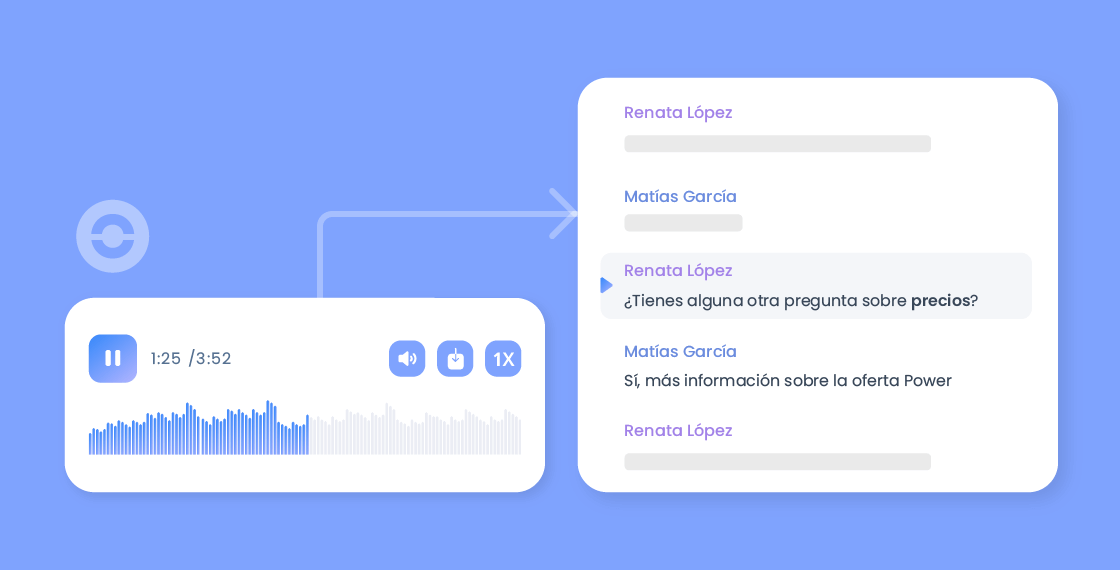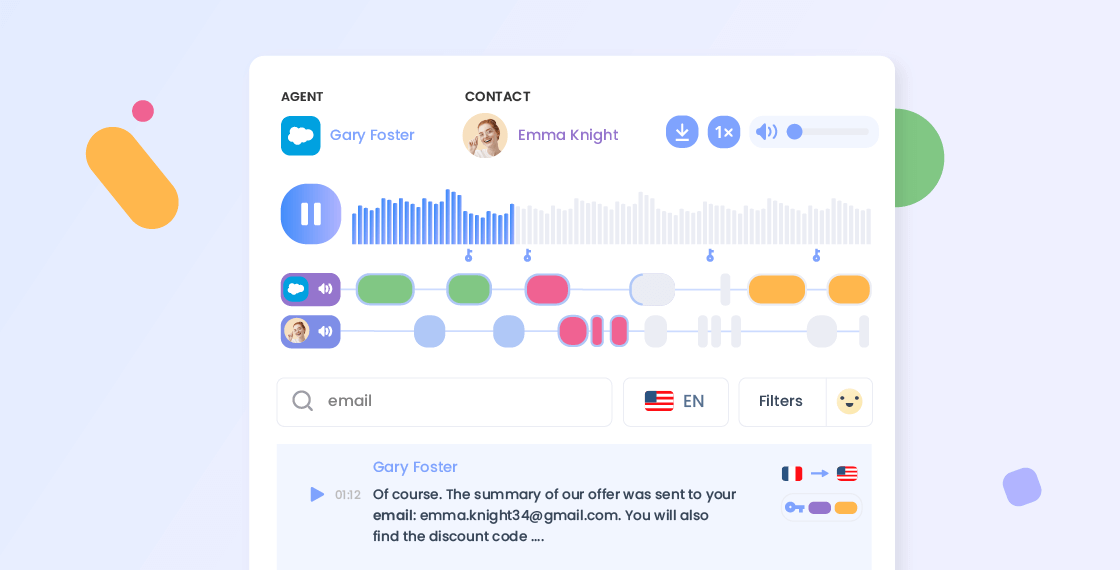Summary
What is sentiment analysis?
The technology will determine the polarity of the excerpt (positive, negative, neutral) in addition to the specific emotions present, the level of urgency, and even any intentions stated. This type of analysis is now commonly used by businesses, who use it to better understand what prospects and customers think of their brand and customer experience.
Given the potential for useful insights, the demand for sentiment analysis tools has increased. Now, there are many tools on the market, which can process varied data from omnichannel communications like emails, call or voice message transcripts, comments on social media, or even opinions on forums or review platforms.
Types of sentiment analysis
Like we covered in the first section of this article, sentiment analysis can classify a text simply on a three point scale: positive, neutral, and negative. But the technology has evolved and can now draw more complex conclusions. Multiple types of analysis have emerged, which provide businesses with the possibility to choose what's most useful for their needs and the type of data available. In the following paragraphs, you'll find a breakdown of the most common types:
Graded sentiment analysis, aka fine-grained sentiment analysis
This category measures the polarity of a text, and is the most well-known and basic. The most specific scale for this type includes five points:
- Very positive
- Positive
- Neutral
- Negative
- Very negative
However, there is also a more basic scale for graded or fine-grained sentiment analysis, which only has three points:
- Positive
- Neutral
- Negative
This scale has many applications, but it's often used to evaluate a large quantity of reviews to understand them quickly and accurately.
Emotion detection sentiment analysis
This is a more specialised classification, since it focuses on deciphering the emotion conveyed by a message, not just polarity. The most common emotions (and therefore the most widely used for categorization) are: joy, sadness, anger and frustration.
To accurately identify the emotions, the AI technology may use either a lexicon (basically, a dictionary that specifies what emotions are conveyed by what words) or machine learning algorithms. Of course, because the emotions expressed by words can vary depending on context, this is a more complex type of sentiment analysis than graded or fine-grained.
Emotion-based categorization is very common in product launches, to determine the extent to which a new product or service meets the expectations of new customers.
Aspect based sentiment analysis
This category enters a new level of specificity because it identifies an emotion expressed and matches it to a specific aspect in the text. So while the two previously mentioned categories have examined a text overall, this one will produce conclusions on specific parts of the written content.
For example, if customer feedback states: “This screen distorts images,” the technology will conclude the customer was expressing a negative opinion about the product's screen. Meanwhile, graded or fine-grained sentiment analysis would only reveal that the text was negative.
Intent-based sentiment analysis
As the name suggests, this goes beyond the positive to negative scale and digs into the purpose behind the written excerpt. The results will usually reveal what the writer or speaker wants to accomplish with their communication. The tech will tell you whether that person is asking a question or making a complaint or request.
As you can imagine, this category is really valuable for customer service departments because it helps them understand what the customer is expressing quickly and provide a useful response.

Why is sentiment analysis important?
Sentiment analysis is important for businesses because it allows you to quickly and accurately process input from customers or prospects. With the resulting valuable insights, you'll be able to optimise the customer experience and build customer loyalty.
Customers and prospects have unparalleled access to businesses through omnichannel communications. Not to mention, they independently generate large quantities of feedback on review platforms or social media.
So having the ability to automatically but accurately distil this content into easily digestible insights allows brands to take action that's directly based on the opinions and desires of its customer base. You can monitor feedback over time to understand shifts in customer or prospects opinions of your brand, or plan for product or service changes based on customer needs.
Sentiment analysis benefits
The enormous quantity of feedback expressed online and through communication channels is both a boon and a bane to businesses. If those opinions expressed aren't properly addressed, brands can face backlash or be perceived as uncaring of whether their clients are actually happy.
On the other hand, if this feedback is well-processed and used for actionable insights, brands can develop strong relationships with their customer base. Ensuring that feedback is taken into account is the main benefit sentiment analysis brings. Here's a few of the ways sentiment analysis facilitates a strong customer relationship:
- Efficient and automated processing and evaluation of data
- Immediate feedback on services, products, or the general custom experience
- A relatively objective analysis–a big plus, considering people often interpret texts differently
Sentiment analysis examples
What kinds of statements can be easily categorised by sentiment analysis technology? And what statements are more difficult for AI to categorise?
Unsurprisingly, the easiest phrases for artificial intelligence to categorise are unequivocal statements that express a clear opinion. As for sentences that are more difficult for technology to classify, they will usually include negation, an adverb that qualifies the statement, a negative term used in a positive way, sarcasm, slang–essentially, anything that muddies the meaning of the statement.
Easy examples of sentiment analysis data
- I love the dinner service at the movie theatre.
- The updated Uber app is easier to use.
- The restaurant's new burger buns are way too sweet.
Difficult examples of sentiment analysis data
- I don't hate Starbucks' new caramel cookie latte.
- Sometimes the pharmacy has poor service.
- There was a crazy twist at the end of this episode.
How does sentiment analysis work?
As mentioned above, AI makes a huge contribution to sentiment analysis. But how does it work? The general process can be broken down as follows:
- Data collection: the application receives conversations, opinions and comments from various sources, such as websites, forums, surveys, social networks, voicemail or calls transcriptions, and so on.
- Natural language processing (NLP): this is a type of AI which allows machines to process and understand human languages so it can perform transcriptions, translations, and other language-related automated tasks.
- Text or audio analysis: the algorithm extracts and studies the structured data. During this stage, the aim is to understand the meaning of what is being expressed, in addition to the emotions associated with that expression. The most basic form, known as fine-grained or graded sentiment analysis, classifies messages into three categories: positive, neutral or negative.
This is a general framework for this technology–but there are different algorithms that can be employed to determine the emotional tone in texts. We've gone over the most common ways to carry out sentiment analysis below.
Rules-based
A rules-based algorithm is exactly what it sounds like. You will provide the computer with a set of rules which allow it to determine the polarity of the sentiments expressed. But, these rules aren't simply a list of do's and don'ts.
There are specific NLP techniques you'll need to use for the rules to be effective, including:
- Lexicons, which are also known as a vocabulary or wordbook, are a dictionary which labels words with its polarity.
- Parsing, a process which determines if a text uses proper grammar rules and “makes sense” or not. Because this step determines if there are syntactical errors, it can also be called syntax analysis or syntactic analysis.
- Tokenization is the process of substituting data with unique identification symbols, also referred to as tokens. You've probably already heard of tokenization in the context of blockchains or NFTs, as the process is used for those technologies too.
- Stemming is the practice of stripping words down to their base form. For example, “running” would be stripped down to “run.” In doing so, a text is normalised and easier for the algorithm to process and understand.
- Part-of-speech tagging sounds complicated but it's actually a dictionary similar to a lexicon. But in this case, the dictionary indicates what part of speech a word is (noun, verb, etc.).
Normally, the rules-based algorithm will use its lexicon to count the negative and positive words in a text. The algorithm then determines the polarity of the text based on if there are more negative or positive words. Though this type of algorithm can be quite effective, it depends on the quality of the techniques used, like the lexicon. At times, rules-based systems can fail to characterise texts correctly because the rules may not cover expressions, irony, sarcasm, etc.
Automatic
In contrast to rules-based approaches, this type of sentiment analysis evolves over time thanks to machine learning. For the algorithm to successfully assign polarity to words and texts, it must be trained. During the training process, the algorithm will learn to associate text to a tag based on the training samples.
- Training and prediction. To properly train the algorithm, you'll provide it with a sentiment-labelled set of data. This allows the algorithm to correctly associate features with the most appropriate label.
- Extract features. In this step, the model will simplify the text (using processes like tokenization) then vectorize it. Vectorizing text is when numbers are assigned to text so it's easier for the algorithm to work with. Once the text has been transformed into numbers, it's then called features. This step is all about simplifying the text so the algorithm can more easily categorise it with a polarity label.
- Predictions. Once the model has been properly trained, you can input new text for polarity classifications. The algorithm will then predict the classification of the text, using what it has learned. In this way, you don't need to rely on predefined (and at times, limited) lexicons.
Classification algorithms
This type of algorithm is commonly used for sentiment analysis and usually trained with pre-labelled data. Classification algorithms will predict the polarity of words and texts based on pattern recognition. There are several types of classification algorithms which use different techniques to predict text sentiment.
- Logistic regression. If you've taken Statistics, you've already seen logistic regression. Logistic regression determines the probability of a dependent variable (Y) given the independent variable (X). This algorithm generates a linear model which is used to predict sentiment (in this case, our dependent variable Y) based on words or phrases (our independent variable X).
- Support vector machine. This algorithm can actually be trained to categorise your text with degrees of polarity. The model will first classify your data as either positive or negative, then plot it on an x- and y-axis. The model then generates a hyperplane to separate the data as best as possible. Ideally, there would be a large distance between the hyperplane and the plotted data points, indicating data points close to each other are expressing similar emotional polarities. For the most complex datasets, the model will also use a z-axis.
- Decision tree. Like logistic regression, you've probably seen decision trees before, as they are a popular flowchart for problem-solving. This is an unsupervised learning model, meaning that the training data is unlabeled. To reach a suitable level of accuracy, the model infers decision rules based on the training data provided.
- K-nearest neighbours. This algorithm is based on the closeness of features, which is usually calculated by Euclidean distance. So when it comes to classifying text polarity, the algorithm will receive features of unlabeled text data, the distance of which will be calculated from the features of the dataset. You will train the K-nearest neighbours algorithm so it can correctly predict which are the closest features to the categories you've defined–in this case, positive, neutral, and negative.
- Naive Bayes. As suggested by the name, this algorithm is based on Bayes's Theorem, which helps to find the probability of an event with random knowledge. The Naive Bayes method assumes each feature is independent, and thus makes an independent and equal contribution to the overall polarity of the text. Given the way Naive Bayes works, it is relatively resilient against limited or poorly labelled data.
Hybrid
A hybrid sentiment analysis is the combination of machine learning and rules-based approaches–ideally taking the best from both worlds. There are many ways to run a hybrid analysis, but it usually produces high-accuracy results because it combines the accuracy of machine learning with the stability and consistency of a lexicon.
Sentiment analysis challenges
Automated sentiment analysis has several limitations. After all, how can a machine possibly detect that a sentence is pure sarcasm?
To this day, there is still no infallible method for fully determining the emotion behind every word, and the fact is that, as language itself is highly complex, the emotions behind the way we say or write a sentence are often highly ambiguous, making it impossible to perform a 100% reliable sentiment analysis.
If the analysis carried out is based on the detection of words that you have previously selected and established in positive, negative and neutral categories, ambiguities may persist.
Irony and sarcasm classically present difficulties to computers, especially if the statements lack context. In the same vein, certain statements of opinion can be problematic for computers to understand too. One common example is the sentence: “It was nice.” This could be said sincerely, in the sense that something was ok but not good, or even pejoratively. Comparisons can also leave algorithms at a loss, as they are often highly subjective: “This is better than last year's version.” Determining polarity is very difficult without information regarding last year's version. Finally, don't forget about emojis. These usually need to be pre-processed before the algorithm can classify them.

Sentiment analysis applications
The insights provided by sentiment analysis have many business applications. This knowledge gives insight into how customers or prospects react to a brand and the various services or products offered by a company. The company can thus obtain conclusive data and even predict future customer behaviour. Mass analysis enables behavioural patterns to be detected, and provides an overview whose results can be fully exploited by different teams.
Let's take a look at a few common sentiment analysis use cases and applications.
Customer service
It's nothing new, but we'll say it all the same: Having great customer service is key to retaining clients and thus growing your brand with a strong customer base. Expectations have only continued to rise, especially as technology advances and consumers expect brands to leverage all the tools available for a stellar experience.
So an AI-powered tool which makes customer service interactions more efficient and effective can go a long way in optimising the customer experience and building customer loyalty.
For example, sentiment analysis and conversation intelligence can be especially helpful in contact centres when it's used in combination with a business phone system. The technology will identify the topics discussed during a phone call. This will allow you to identify trends in your client interactions and search conversations. Empower by Ringover performs those functions and others, like noting key moments within the call based on the emotions the customer is expressing. With this information at hand, you get greater insight into what clients think of your product and the service they are receiving. In the end, optimising your customer service will be a straightforward process, as these real-time analytics will inform your strategy changes.
Sales
Salespeople spend hundreds of hours on the phone interacting with clients–which adds up to hundreds of hours of valuable data that often goes unleveraged. That's where sentiment analysis comes in, in the form of a sales enablement tool. Once you've implemented a tool like Empower, you'll have access to several useful features. For supervisors, you'll no longer randomly click into call recordings to check the effectiveness of your teams. You'll be able to skim short summaries which indicate if the conversation was out of the ordinary and merits a closer look. Plus, the topics discussed will be automatically tagged so you can easily search conversations.
One other key feature of sentiment analysis-powered sales enablement tools is the analytics they provide. Each salesperson will have personalised KPIs regarding monologues, interruptions, and more.
Social media monitoring
The sheer quantity of customer feedback generated on social media is nothing less than overwhelming for brands to keep up with manually. And yet, if you're not aware of what people are saying online about your brand, the consequences can be serious. People may express their desires for different products or changes to your service–and thus you can miss chances to cater to your clients needs. Worse, people may criticise your brand in some form or fashion , and if you're not aware you risk being perceived as–or actually–out of touch.
Sentiment analysis compiles the data generated online, and can not only determine if the emotions expressed are positive, negative, or neutral, but also identify the topics discussed. It can help you avoid a PR catastrophe, or zero in on the products, services, and marketing that resonate with your customer base.
Brand monitoring
The Internet is a large place–there's plenty of places where people can discuss your brand: on news sites, forums, in product reviews–there are plenty of options. This content can have just as large an impact on your success as chatter on social media–and the impact can happen quickly. Negative content regarding your brand can go viral just as easily as positive content, after all.
That's why more and more brands have turned to brand monitoring. Brand monitoring is the use of artificial intelligence to pinpoint brand mentions in digital media. If you keep a close eye on what's being said online, you'll be better positioned to connect with your client and prospect bases and grow them successfully.
Voice of customer (VOC)
Voice of the customer includes all the input customers give on their experiences–this can include responses to surveys and their expectations regarding your product and service. Many brands use NPS scores, which are numerical and thus can easily be collected and evaluated. But, clients provide the richest information when in the form of qualitative data, which is also much more difficult and inefficient to process.
Whatever form the voice of the customer information takes, you can use algorithm-based analysis to determine polarity quickly and accurately.
Market research
When you're entering a new geographic area or industry, trying to predict upcoming trends, or simply better understand your competitors, market research can provide invaluable information. And once you integrate sentiment analysis into your market research process, you'll be able to track long-term trends and closely monitor your competitors.
Sentiment analysis improves your reach and allows you a more global view than you would have otherwise. The automated collection of information allows you to increase your research foundation, and with a proper sentiment analysis, you'll have a thorough understanding of market movements.

Sentiment analysis tools and tutorials
Though the thought of integrating artificial intelligence into your business may be intimidating. However, recent technology has emerged that have made it easy to onboard AI tools and see the immediate advantages. Below, you'll find a couple of examples.
Empower by Ringover
Empower is a sentiment analysis tool that supports sales and customer service teams. Since it integrates with your business phone system, it's able to automatically transcribe phone calls and analyse the text generated. Then, it surfaces the topics discussed, the emotions expressed, and even provides individual representatives with KPIs on how many times they had a monologue, interrupted the prospect or client, and more. Curious to know more? You can try out the tool yourself with a free trial.
Free online sentiment analysis tools
There are a few sentiment analysis tools that are free. However, they are very limited in their use, as you can often only enter a certain number of words. Both MonkeyLearn and ClientZen offer limited free services, but it's a best practice to check their functionalities before you dive into using them. Each sentiment analysis tool does something different, and before you enter your data into a tool, make sure it serves your purposes. After all, when you use a free Internet-based service, the company providing the service may use your data for other purposes.
Sentiment analysis FAQ
How does sentiment analysis in NLP work?
Sentiment analysis is a technique that uses mathematics, natural language processing (NLP), and sometimes machine learning or artificial intelligence to identify the emotions expressed in a text. There are many business applications for NLP-based sentiment analysis, especially when it comes to optimising customer service, call centre operations, or sales.
What is an example of a sentiment analysis statement?
Sentiment analysis can reveal the polarity of emotions in opinions, appraisals, emotions, attitudes, categorising them as positive, negative, or neutral. This technology is especially useful for businesses who are monitoring the quality of the customer experience.
What is a sentiment analysis tool?
A sentiment analysis is a software based on artificial intelligence (AI) which analyses text to identify and classify subjective expressions of emotion. In this way, a sentiment analysis tool will give you insight into how the customers and prospects feel about your product or service.
What is intent analysis vs sentiment analysis?
Sentiment analysis uses AI and natural language processing (NLP) to identify the polarity of emotions expressed in text data. Intent analysis determines the speaker's purpose. So a sentiment analysis may conclude a text is expressing positive emotions regarding a new product, while the intent analysis concludes the speaker is going to purchase the product.
Does Ringover have sentiment analysis?
Empower by Ringover provides businesses with sentiment analysis capabilities. Empower is a sales enablement tool that supports sales and customer service teams. After a customer or prospect phone call, Empower will automatically transcribe the call and complete a sentiment analysis. Not only will it identify the emotions expressed by the speaker, it will also identify the topics covered. Finally, the representative will receive personalised performance metrics, including how many monologues and turns to speak they had.


